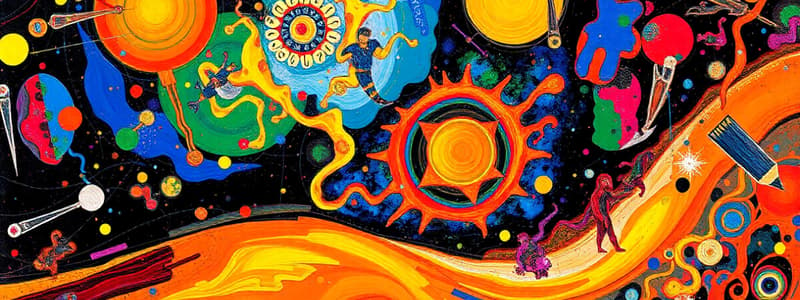Podcast
Questions and Answers
Which of the following best describes the significance of the Big Bang theory in the context of evolutionary biology?
Which of the following best describes the significance of the Big Bang theory in the context of evolutionary biology?
- It provides direct evidence of the first self-replicating molecules.
- It details the process of natural selection in the early universe.
- It explains the origin of the universe, providing a context for understanding the origin and evolution of life. (correct)
- It identifies the specific elements that were present when life first formed.
Miller's experiment demonstrated which important step in the origin of life?
Miller's experiment demonstrated which important step in the origin of life?
- The synthesis of organic molecules from inorganic compounds under early Earth conditions. (correct)
- The emergence of aerobic respiration.
- The formation of the first cells.
- The creation of self-replicating molecules.
Why was the theory of spontaneous generation eventually dismissed?
Why was the theory of spontaneous generation eventually dismissed?
- It was disproven by experiments showing that life only arises from pre-existing life. (correct)
- It contradicted the principle of chemical evolution.
- It could not explain the formation of complex organic molecules.
- It was incompatible with the idea of natural selection.
Which idea is most closely associated with the concept of chemical evolution?
Which idea is most closely associated with the concept of chemical evolution?
What evidence supports the idea that similar chemical processes might be occurring elsewhere in space?
What evidence supports the idea that similar chemical processes might be occurring elsewhere in space?
What is a key difference between the religious theory of special creation and Darwin's theory of evolution?
What is a key difference between the religious theory of special creation and Darwin's theory of evolution?
Which of the following statements best reflects Darwin's concept of 'fitness'?
Which of the following statements best reflects Darwin's concept of 'fitness'?
What is the significance of fossils in understanding evolution?
What is the significance of fossils in understanding evolution?
How did Karl Ernst von Baer's work refine the understanding of embryological evidence for evolution?
How did Karl Ernst von Baer's work refine the understanding of embryological evidence for evolution?
What is the key difference between homologous and analogous structures?
What is the key difference between homologous and analogous structures?
The peppered moth example demonstrates what about natural selection?
The peppered moth example demonstrates what about natural selection?
What does the term 'adaptive radiation' refer to in evolutionary biology?
What does the term 'adaptive radiation' refer to in evolutionary biology?
What is the evolutionary significance of the observation that placental mammals and Australian marsupials have evolved similar forms?
What is the evolutionary significance of the observation that placental mammals and Australian marsupials have evolved similar forms?
According to Darwinian theory, what is the primary driving force behind evolution?
According to Darwinian theory, what is the primary driving force behind evolution?
What is the role of mutations in the process of evolution?
What is the role of mutations in the process of evolution?
What does the Hardy-Weinberg principle state about allele frequencies in a population?
What does the Hardy-Weinberg principle state about allele frequencies in a population?
Which of the following is NOT a factor that can disrupt Hardy-Weinberg equilibrium?
Which of the following is NOT a factor that can disrupt Hardy-Weinberg equilibrium?
What is the 'founder effect' in the context of genetic drift?
What is the 'founder effect' in the context of genetic drift?
Which of the following statements best describes the sequence of human evolution?
Which of the following statements best describes the sequence of human evolution?
What is significant about the discovery of Coelacanth in the 20th century?
What is significant about the discovery of Coelacanth in the 20th century?
Flashcards
Evolutionary Biology
Evolutionary Biology
The study of the history of life forms on Earth.
Big Bang Theory
Big Bang Theory
The theory that the universe originated from a singular, massive explosion.
Spontaneous Generation
Spontaneous Generation
Early idea that life arose from decaying matter.
Chemical Evolution
Chemical Evolution
The concept that life could have come from pre-existing non-living organic molecules.
Signup and view all the flashcards
Theory of Special Creation
Theory of Special Creation
The theory that all living organisms were created as they are.
Signup and view all the flashcards
Natural Selection
Natural Selection
The process by which characteristics enabling better survival are selected in nature.
Signup and view all the flashcards
Fossils
Fossils
Remains of hard parts of life-forms found in rocks.
Signup and view all the flashcards
Embryological Support
Embryological Support
Similarities among organisms observed during the embryonic stage, absent in adults.
Signup and view all the flashcards
Divergent Evolution
Divergent Evolution
Evolution where similar anatomical structures evolve along different directions to adapt to different needs.
Signup and view all the flashcards
Convergent Evolution
Convergent Evolution
Different structures evolving for the same function, resulting in similarity.
Signup and view all the flashcards
Homology
Homology
Homology based on divergent evolution, similarity due to common ancestry.
Signup and view all the flashcards
Adaptive Radiation
Adaptive Radiation
A process where different species evolve in a given geographical area, radiating to other areas.
Signup and view all the flashcards
Biological Evolution
Biological Evolution
Evolution by natural selection when cellular forms of life with metabolic differences originated.
Signup and view all the flashcards
Darwin's Key Concepts
Darwin's Key Concepts
The two key concepts of Darwinian evolution; branching decent and natural selection.
Signup and view all the flashcards
Mutations (deVries)
Mutations (deVries)
Large differences arising suddenly in a population.
Signup and view all the flashcards
Saltation
Saltation
Single step large mutation causing speciation.
Signup and view all the flashcards
Hardy-Weinberg Principle
Hardy-Weinberg Principle
Allele frequencies in a population are stable and constant from generation to generation.
Signup and view all the flashcards
Disturbance in Genetic Equilibrium
Disturbance in Genetic Equilibrium
Change of frequency of alleles in a population resulting in evolution.
Signup and view all the flashcards
Founder Effect
Founder Effect
Describes an original population that becomes the founder of a new species.
Signup and view all the flashcards
Variation
Variation
Variations due to mutations or recombination during gametogenesis results in changed frequency of genes and alleles.
Signup and view all the flashcardsStudy Notes
- Evolutionary Biology studies the history of life on Earth.
Evolution
- It is necessary to understand the origins of life, Earth, stars, and the universe
- Changes in flora and fauna have occurred of millions of years
Origin of Life
- Looking at stars equates to looking back in time
- Stellar distances get measured by light years
- What one observes today started its journey millions of years ago from trillions of kilometers away
- Origin of life is a unique cosmological event
- The universe approximates to 20 billion years old
- It is mainly comprised of galaxies with stars, gas, and dust
- Earth is comparatively infinitesimal
- The Big Bang theory describes the origin of the universe
- After the Big Bang, the universe expanded decreasing the temperature
- Hydrogen and Helium then formed
- Gases then condensed by gravitation to form galaxies
- Earth formed 4.5 billion years ago in the Milky Way solar system
- The early Earth lacked an atmosphere
- The molten surface released water vapor, methane, carbon dioxide, and ammonia
- UV rays broke water, releasing hydrogen and oxygen
- Hydrogen escaped and combined with ammonia and methane to produce water and CO₂
- The ozone layer was formed
- Water vapor cooled and rained, forming oceans
- Life arose 500 million years after Earth formation
- Some theorize that life came from spores from different planets a theory called "Panspermia"
- Spontaneous generation theory stated that life came from decaying matter
- Louis Pasteur disproved spontaneous generation through experimentation
- Life originates from pre-existing life
- Oparin and Haldane proposed that life developed from non-living organic molecules through chemical evolution
- The conditions on earth included high temperatures, volcanic storms and a reducing atmosphere
- S.L. Miller replicated these conditions in a lab, creating amino acids
- Further experiments produced sugars, nitrogen bases, pigments, and fats
- Analysis of meteorites revealed similar compounds
- Early evolution's first part, chemical evolution, is largely accepted
- The origin of self-replicating metabolic capsules remains unknown
- The initial non-cellular life forms are thought to have arisen 3 billion years earlier
- These may have been giant molecules like RNA and proteins
Beginning of Cellular Life
- The first cells possibly arose around 2000 million years ago
- Primarily single-celled organisms in water, according to the theory of biogenesis
- The evolutionary development from non-living matter is widely accepted
- However, the transition of these initial entities into modern biodiversity is still a story
Evolution of Life Forms - A Theory
- Conventional literature describes the special creation theory
- Three tenets include all species were made as they are, diversity has been the unchanged, and the Earth is only 4000 years old
- Charles Darwin made observations on the H.M.S. Beagle
- Existing life shares likenesses with life forms from millions of years prior
- Many of these former life forms are currently extinct
- Life experiences gradual evolution
- Any population has variations
Studying That Suits You
Use AI to generate personalized quizzes and flashcards to suit your learning preferences.




